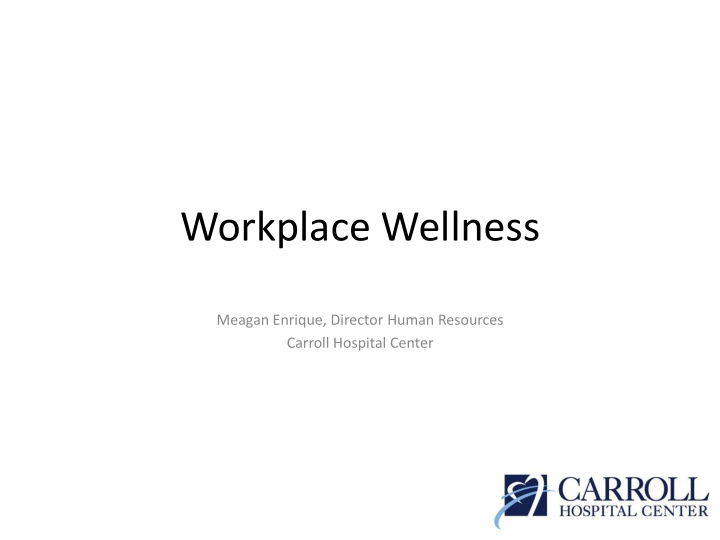



Workplace Wellness Meagan Enrique, Director Human Resources Carroll Hospital Center
Wellness Philosophy • As the premier healthcare provider for Carroll County, it is our belief that it is important for our organization and Associate population to set an example for the boarder community, both members and employers, with regard to wellness. • As the premier employer in Carroll County, it is important for the hospital to provide the tools and resources to improve the overall health and well-being of our Associates.
State of CHC Health • In 2005, the top 5 Diagnostic Categories cost the medical plan $2.4 million: – Circulatory – Digestive Disease – Musculoskeletal Disorders – Mental Health Issues – Respiratory Disease • This represented 51% of all claims paid • Top 5 prescribed drug indications in 2005 cost over $650k or 51% of all prescriptions paid: – Depression – Ulcer Disease – High Cholesterol – High Blood Pressure – Severe Pain
State of CHC Health • In 2005 only 5% of medical plan costs were for preventative care • Most common behaviors/conditions related to health risks: – Smoking – Eating habits – Obesity • We did have some wellness ideas/approaches, however; they were disjointed • Led the County by becoming the first Smoke Free Organization in Carroll County • GOAL: – Establish a cohesive, formal wellness program for all Associates that would involve all departments and potentially affect many facets of our Associates’ lives
Why Wellness? • If you improve the health and well being of your employees: – Quality of life improves – Healthcare cost are reduced – Disability is controlled – Productivity is enhanced
Progressive Program Implementation • 2007 Program Introduction – Promoted HRA – 10% Health Premium Discount for HRA Participation – Monthly Education Sessions – Point Structure Implemented – CHC receives Health and Wellness Trailblazer Award
Program Implementation • 2008 – Wellness Website Introduction – HRAs year 2 – 10% discount for HRA plus 2 Wellness Events – Walking Program Introduced – CHC receives Trailblazer award – year 2 – Wellness Point Redemption Day conducted
Program Implementation • 2009 – 10% discount for HRA participation plus 20 Wellness Points – CHC receives Trailblazer award – year 3 – 2 nd Wellness Redemption Day held
Program Implementation • 2010 – No changes – CHC receives Trailblazer award – year 4 – CHC receives AHA Platinum Start! Fit Friendly Company – 3 rd Wellness Redemption Day
Program Implementation • 2011 – HRA push – moving towards mandatory – New Point Structure – Incentives for non-health plan participants – Incentives for disease management program – Wellness coaching – CHC receives Trailblazer award – year 5 and Fit Friendly Company – Year 2
Program Implementation • 2012 – 50 points necessary for Wellness Discount – must be in four categories: • HRA – 15 points max • Healthy Education – 15 points max • Healthy Lifestyle – 15 points max • Healthy Prevention – 25 points max – Cash incentive for completion by non-health plan participants – Education towards mandatory requirements for 2013 – CHC receives Trailblazer award – year 6 and Fit Friendly Company – year 3
Program Implementation • 2013 – Mandatory HRA’s for health plan coverage • Disease Management for high risk Associates – Voluntary nicotine swab • Free cessation coverage for positive – Mandatory Flu Vaccines – Everything else continues – CHC receives Trailblazer award – year 7 and Fit Friendly Company – year 4
Program Implementation • 2014 – Mandatory HRA’s - disease management for high risk Associates – Mandatory Nicotine swabs - $25.00 per pay surcharge for positive swabs – Mandatory Flu Vaccines – Begin Tracking Outcomes: • BMI (18 – 24.9), Tobacco Free, 2 Preventative visits, Blood Pressure (<120/80), Exercise Tracking (1-3 times/week) – CHC receives Trailblazer Award – year 8 , Fit Friendly Company – year 5 & American Cancer Society CEO Gold Standard- year 1 (First Hospital in MD!)
Program Implementation • Plan for 2015 – Everything continues – Positive nicotine – surcharge increases to $50.00 per pay – No longer hire people who use nicotine – Award points based on outcomes – Implementation of new system
Results • Annual PMPM costs declining overall since 2008 • Disease Management ROI year over year $5:$1 • Drug costs down 31% • Reduced employed smoking population by 15% • Increased Primary Care Office Visits – New Patient Office Visits up 25.7% • Reduced Associates in High Risk category (200 from 2010 to 2012) • 21.9% Reduction in Unscheduled Absences • Total cost of program: • 2007 - $50k • 2014 - $80K (additional disease management) • 2015 – projected $300K (results based cash incentives)
Recommend
More recommend